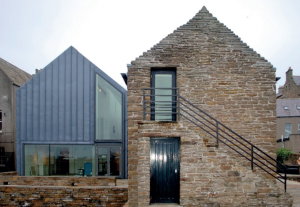 The technical complexities of repair and conservation of traditional buildings are an issue which many IHBC members are familiar with, Jessica Hunnisset invites us to consider how to retain the character and authenticity of historic properties whilst ensuring that they are robust enough to withstand a wetter and windier climate (in this instance on the island of Orkney) in issue 158 of Context.
The technical complexities of repair and conservation of traditional buildings are an issue which many IHBC members are familiar with, Jessica Hunnisset invites us to consider how to retain the character and authenticity of historic properties whilst ensuring that they are robust enough to withstand a wetter and windier climate (in this instance on the island of Orkney) in issue 158 of Context.
image: Context 158, p31 – Jessica Hunnisett
The traditional construction techniques of the rural landscape of Orkney is the shallow stepped gables, formed from slabs of local stone, and carefully tooled and graded to form a gable wall. The masonry of these gable walls is immaculately constructed from slim sections of bare, flaggy stone. The gables sweep up to a triangular peak, surmounted by a single pyramidal stone, or rise to form chimneys, substantial relative to the size of the dwellings, and often supporting only a single pot. Chimneys are detailed with a single or double row of slates or riven flagstone to form a drip detail, an essential protective element where driving rain can quickly result in the chimney and gable becoming saturated. The gable and skew too represent a critical element in a building’s construction, taking the force of both vertical and horizontal weathering.
Buildings in the coastal settlements in Orkney tend to face gable end on to the sea, so these walls need to be robust and the detailing weathertight. It is possible that these rural buildings were never harled, but sheltered areas sometimes reveal fragments of thin lime harling, suggesting that the walls may once have been finished more robustly, protecting their cores of clay or lime mortar. Perhaps centuries of scouring wind and rain have simply blasted away the soft lime coating, leaving the bones exposed, and confusing any observer who tries to interpret the construction of these unassuming buildings. Many of the buildings that survive unaltered show remnants of thin, lime-rich harling, but some are so weathered as to appear almost dry-built, with scant evidence of any protective finish at all. Experience suggests that the scouring winds of the northern isles can make short work of soft lime finishes without regular maintenance. As a consequence the bare stone appearance has become familiar, and often admired.
How, then, do we balance the repair and care of the traditional buildings with the requirement to maintain the comfort of residents and users, whilst taking an appropriate approach to building repair and maintenance? Pier Arts Centre in Stomness offers a useful case study and debating point, soon to be published by Historic Environment Scotland as a case study.
View the IHBC Context article
